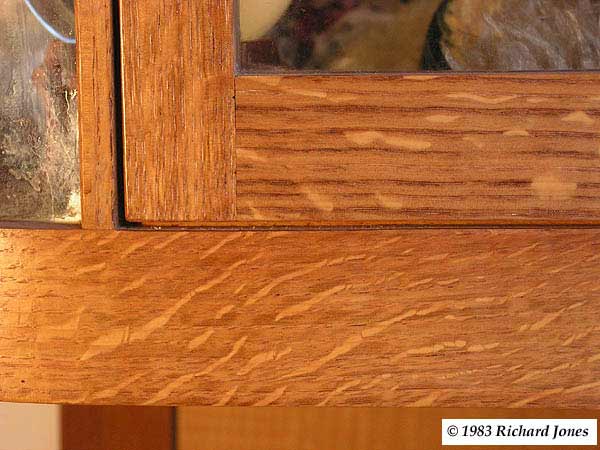You are using an out of date browser. It may not display this or other websites correctly.
You should upgrade or use an alternative browser.
You should upgrade or use an alternative browser.
Brown Oak outdoor seating project
- Thread starter earthwoodcrafts.com
- Start date

Help Support UKworkshop.co.uk:
This site may earn a commission from merchant affiliate
links, including eBay, Amazon, and others.
custard":wfm431qj said:Also I'm not sure where I'd pitch it, should I wait for a relatively straight forward project that's got broad appeal, or do something a bit trickier that's not been well covered on the internet, but would only be relevant for a smaller group?
FWIW, as I kind of said in another thread recently: as a weekend hobbyist I'm quite interested in reading about how complicated bits of furniture go together even if I'm unlikely to ever make anything similar myself. Sometimes there'll be interesting tips that are still relevant, and other times it's just fascinating to see a master at work. If your goal is to be specifically useful to your fellow cabinetmakers, then sure - that's not much use. But if your goal is just to present something interesting to your fellow forum users, then I suspect a lot of people will find things interesting even if they're never going to build one themselves.
custard
Established Member
JakeS":28i5nicu said:it's just fascinating to see a master at work
Kind words Jake, but unfortunately I'm just a bog standard journeyman level furniture maker. I define that as, if I can draw something then I can probably make it, but a master has the ability to figure out how to make things that he can't actually draw and have never previously been made. Here's a good example,
http://www.johnmakepeacefurniture.com/j ... chair.html
I know the guy who made that chair (it's not John Makepeace by the way) and he really is a master. I still need at least a few small flat reference surfaces on my furniture builds, so no way am I in his league!
earthwoodcrafts.com
New member
thats alright then David123 :wink:
beds looking good and will last a long time for sure.
Custard, that is some very very beautiful stock you've got there. you can consider yourself lucky as it is not easy to find timber like that.
I got my hands on a couple of really warped boards of tiger oak where I could barely use 50% of it. one board is still in storage but managed to build a trinket box out of one.
cheers,
Philipp.
beds looking good and will last a long time for sure.
Custard, that is some very very beautiful stock you've got there. you can consider yourself lucky as it is not easy to find timber like that.
I got my hands on a couple of really warped boards of tiger oak where I could barely use 50% of it. one board is still in storage but managed to build a trinket box out of one.
cheers,
Philipp.
Attachments
beganasatree
Established Member
Jake you have just spoken about myself and others on here . I love seeing and reading about other peoples triumphs and tribulations.
Peter.
Peter.
Random Orbital Bob
Established Member
I've just had a chance to dig out some snaps of the bowl I turned from the brown oak next door to me. Recall this had been on the ground for nearly 30 years before being harvested so must have been very infested. Oddly the colour is very similar to Custard's examples but it also has those rather tiger like streaks too and I remember them from turning it. So I'm now unsure if this would be termed Tiger or Brown Oak or indeed as Custard has mentioned what the timescales involved are.
One thing I'm certain of, the wood is absolutely delightful, striped or otherwise.
One thing I'm certain of, the wood is absolutely delightful, striped or otherwise.
Attachments

£17.99 (£1.80 / count)
£27.44 (£2.74 / count)
3M 8822 Disposable-fine dust mask FFP2 (10-pack)
Amazon.co.uk

£12.50 (£1,250.00 / kg)
£14.45 (£1,445.00 / kg)
JSP M632 FFP3moulded Disposable Dustmask (Box of 10) One Size suitable for Construction, DIY, Industrial, Sanding, dust protection 99 Percent particle filtration Conforms and Complies to EN 149
Amazon.co.uk

£24.99
Facemoon Reusable Masks,Safety Masks,Dual Filter Masks, Paint, Dust, Epoxy Resin, Construction, Welding, Sanding, Woodworking, Chemical Reusable Gas Masks
ShenZHEN CIRY MINGYANG LITIAN ELECTRONIC ECOMMERCE

£238.91
£360.17
Trend Portable Benchtop Router Table with Robust Construction for Workshop & Site Use, 240V, CRT/MK3
Amazon.co.uk
earthwoodcrafts.com
New member
really like the end grain as well of that tiger/brown oak bowl Rob.
monkeybiter
Established Member
earthwoodcrafts.com":39mzmore said:really like the end grain as well of that tiger/brown oak bowl Rob.
+1, very suggestive of movement.
Sgian Dubh
Established Member
They will, as illustrated below. You're looking at a piece of interior furniture with an English oak carcase and a glazed brown oak door frame: after just two or three years it was hard to tell the brown oak from the 'normal' oak. I wouldn't specify brown oak for an external item because, as others have already said, it's already partially decayed. Secondly, I suspect you'll largely be wasting your time trying to preserve the distinctive colour differences with a clear finish. Given a year or so, all the oak will likely be of a similar colour - mostly grey probably. Thirdly, why pay extra for something that's not as durable as uninfected oak, and also won't remain distinctively browner, whether it's brown oak or tiger oak.earthwoodcrafts.com":2ym8pn3s said:... my worry is that over time the colour difference will fade and both timbers will look the same ...

Brown oak is the result of infection by Fistulina hepatica in a live tree. Beefsteak fungus or ox-tongue fungus are the common names for this fungus. The fungus usually infects the tree through a large wound such as those found after pruning a sizeable branch or at the ragged torn site of a fallen limb. It takes some years for the distinctive colour to develop and felling the tree at the right time is the key to getting a large quantity of usable brown wood. Felling the tree too late results in soft, degraded and unusable timber. Americans have the attractive phrase ‘punky’ to describe ‘decorative’ rots which are so severe the wood is usually too soft to use for anything. Keeping the log in the round for a few years after felling emphasises or darkens the colour. Brown oak shouldn’t be used for structural parts in demanding situations. Brown oak is almost always more expensive than uninfected oak and it’s my experience it’s most often used quite sparingly, e.g., for table or cabinet tops, for door frames or, conversely, as door panels. Slainte.
Similar threads
- Replies
- 6
- Views
- 499




































